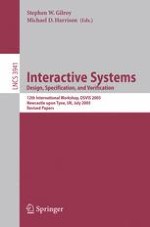2006 | Book
Interactive Systems. Design, Specification, and Verification
12th International Workshop, DSVIS 2005, Newcastle upon Tyne, UK, July 13-15, 2005. Revised Papers
Editors: Stephen W. Gilroy, Michael D. Harrison
Publisher: Springer Berlin Heidelberg
Book Series : Lecture Notes in Computer Science
